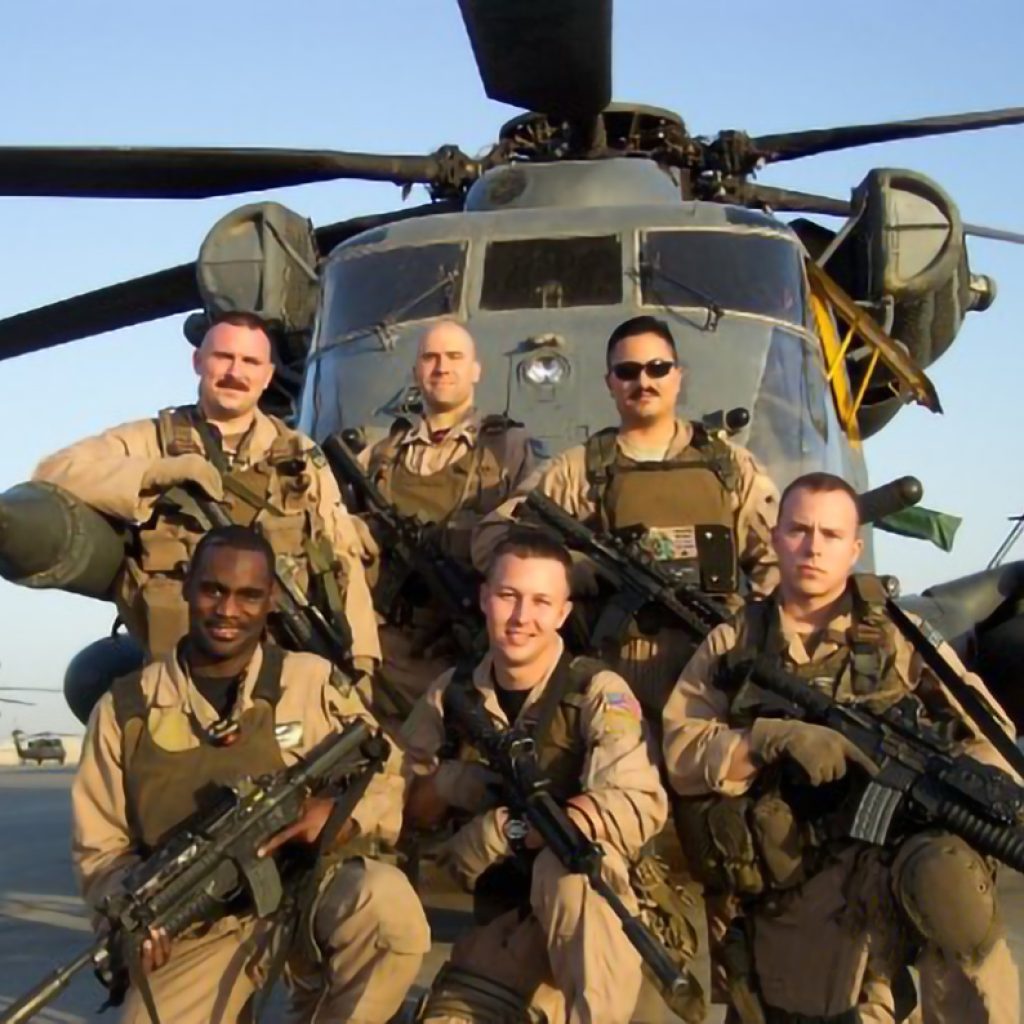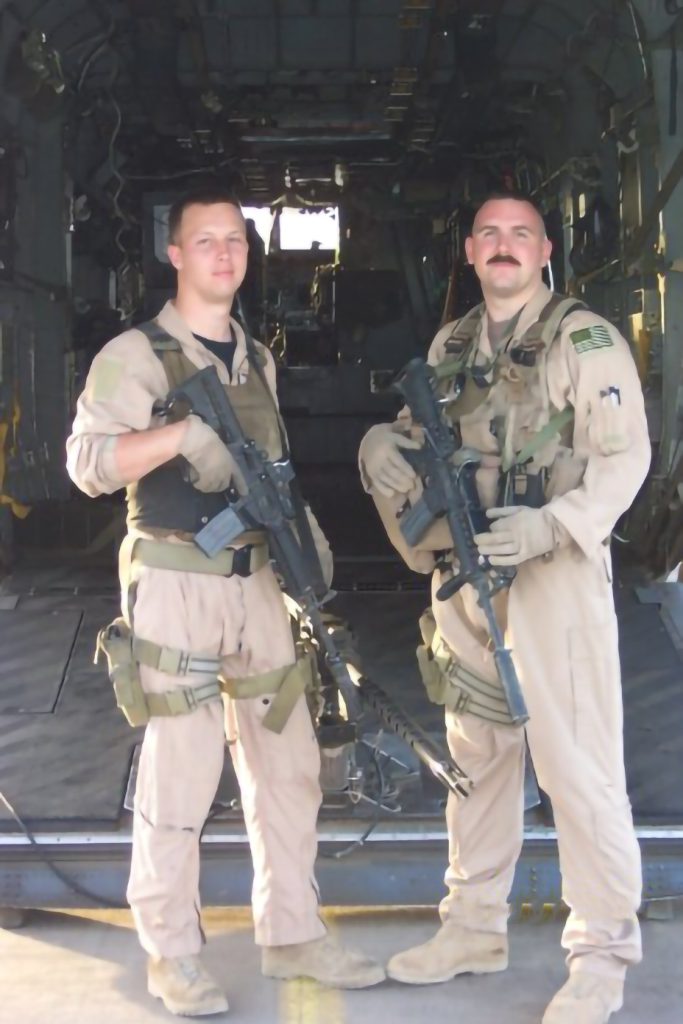Air Force veteran and attorney Aaron Kimsey found friendship and freedom on the water
Some 500 miles due west of Knoxville, the teeming waters of Arkansas’ White River lure anglers from around the world to fish for trout—rainbow, brown, cutthroat, and brook—with fly rods in hand and hope in their hearts: hope not only to hook a keeper but also to enjoy the kind of sublime, sun-sparkling day on the water that almost everyone of a certain age associates with Robert Redford and Brad Pitt in A River Runs Through It.
On a brisk February morning in 2020, longtime flyfishing addict Aaron Kimsey, a US Air Force veteran and tireless attorney with a growing law firm in Sevierville, found himself within a stone’s throw of the White. But he wasn’t there to don a vest laden with lures, palm a reel, or cast a line. He had given up fishing the previous year after the death of a beloved mentor, dear friend, and fishing buddy. Attorney Bill Anderson’s influence had effectively saved Kimsey’s life in the years after his military service ended, as he struggled to face the aftermath of life-or-death combat and suffered through lonely days and nights without the structure, purpose, and brotherhood the military had provided.
It was Anderson who had given Kimsey his first post-military job and inspired him to pursue a career in the law. The duo had trekked to the ends of the earth together, fishing from Alaska to Argentina, sharing a kinship that Kimsey had not experienced growing up, in large part because his own father was in jail for most of those formative years.
So painful was Anderson’s passing that Kimsey couldn’t bear the thought of wading into a stream without him; the memories were too precious, the pain too raw.
“It was really difficult on me,” Kimsey recalls. “He was my boss first, but he became my best friend and a father figure. He helped bring me back from the brink and round off my edges. He was there for me; he was my rock.”
The reason for Kimsey’s trip to Arkansas was not to fish but to pick up a dog to take back home. Yet a thought tugged at his heart and mind: Maybe it’s time. Maybe Bill would tell me to get back in the river. Maybe he’d even be with me in spirit, whispering that it’s okay, the memories we shared will never die—but now it’s time to make some new ones…
Not Quite a Flying Start
Aaron Kimsey was born in Knoxville, but his family lived in Murfreesboro for several years of his childhood. After his parents divorced, Kimsey moved with his mother and two brothers to Maryville, and then to Morristown when he was in fifth grade. Kimsey says his father “was a phenomenal individual—as long as he was sober.” Alcohol and other factors led to crime that confined the elder Kimsey to prison. Kimsey recalls visiting his dad on weekends at Brushy Mountain State Penitentiary.
At 16, Kimsey started a company that built and repaired computers. Meanwhile, a stepfather “was mentally and somewhat physically abusive,” he says. “I was a very angry youth.” To get out from underneath that situation, he enlisted in the Air Force—“they were paying huge bonuses”—right before graduating from Morristown West High School. He shipped out soon after receiving his diploma.
His military service, spanning 2000 to 2008, was a blend of the mundane and the manic, beginning with basic training along with tech and avionics school, right through to becoming a guidance-control systems specialist and later flying on covert, low-level missions in Iraq.
Early on, his orders to Davis Air Force Base prompted Kimsey, a Tennessee homebody, to ask his mom, “Where in the **** is Tucson, Arizona?” She laughed and told him it was way out west.
He was part of the 42nd Electronic Combat Squadron of Airborne Command and Control Center (ABCCC), supporting airborne warning and control system (AWACS) aircraft in classified activities. He later worked with the C-130 Hercules military transport aircraft. A move to the 355th Component Maintenance Squadron had Kimsey inspecting and troubleshooting avionics, navigation, computer, electronic warfare, and photographic equipment.

The broad expertise he amassed in short order “allowed me to deploy with other squadrons, because I was able to do anything you could think of.” For example, he worked with the 41st ECS supporting the EC-130H Compass Call communications-jamming aircraft.
Battle Tested, Battle Weary
When the military started downsizing some of those operations, the service “told me I could get out, or I could go into a ‘critically manned’ career field—the most dangerous jobs in the Air Force. I was single and divorced at the time, and I wanted to retrain.”
That meant taking the harder path, but Kimsey, a go-getter, was ready to go and get it. He went to flight school. He endured Survival, Evasion, Resistance, and Escape (SERE) training, which included search evasion, prisoner of war (POW), and survival skills. “Looking back, all of that was great for me, learning self-control, understanding how to handle pressure.”
Kimsey “begged to get into the MH-53M program, the biggest, baddest helicopter out there.” The Air Force was using the MH-53M for covert incursions into enemy territory—long-range, low-level missions to insert, extract, and resupply special ops forces. We’re talking harrowing, high-risk missions.

While stationed with the 20th Special Ops Squadron in Ft. Walton Beach, Florida, Kimsey came to appreciate the way the military melds high-powered men and women into laser-focused teams. “We were all type-A individuals, working together well, mission-driven, acting in concert; it’s like a symphony,” he says. “I was very fortunate to work with the 20th, by far the best job I had in the military.”
Kimsey was later deployed with the 41st, a C-130 squadron, to Djibouti in the Horn of Africa on the Gulf of Aden, “the second-hottest place on earth, and it felt like it,” he says.
In 2007, he was deployed to Iraq with the 20th as a flight engineer on the MH-53M. “The mission was infiltration, exfiltration, and resupply of special forces. We went and picked up Navy Seals and others and took them where they needed to go. Working with such high-level operators was an absolute honor.”
Kimsey would find himself “sitting between two pilots, controlling the systems—radio, navigation—50 feet off the ground, weaving between trees, wires, having to dodge obstacles quickly.” He also served as a right-door gunner and hoist operator. “I ran either a 50-caliber machine gun or a mini-gun out the window to protect the aircraft. We engaged the enemy frequently.”
Kimsey completed that intense deployment and returned stateside, where he was honorably discharged in 2008. He would receive three Air Medals, awarded for single acts of bravery and heroism.
Reflecting on his service, he emphasizes that “the people I worked with are by far the highlight of my military experience. Your friends, your fellow soldiers, are right there with you, going through the good and the bad, like a second family.” Noting the high rate of veteran suicide, Kimsey attributes much of the epidemic to “the loss of that support structure and way of life. I’ve never found anything like it.”
Another factor is the combat that many vets have endured, including seeing comrades fall and ending the lives of combatants. “It was hard on me,” he says.
Not Resting His Case
Post-military life began with struggles with alcohol and working through tough memories. “It’s difficult to understand,” he says, “but here’s an example: You’re sitting outside your tent in the desert, smoking a cigarette, when a warning siren goes off because your base is being mortared. The first time, you feel desperate fear. After a while, you don’t even flinch. It becomes normal—the worst stuff becomes normal.
“I was lost, not in a great place mentally,” he says. It was in that fog that Anderson, a man for whom Kimsey’s mother had worked—a fellow veteran who had served with the 101st Airborne—invited Kimsey to Key West to work for him. Over several years, Kimsey regained his bearings and opted to return to college, eventually graduating from East Tennessee State University and then Lincoln Memorial University’s Duncan School of Law in Knoxville, where he took night classes after work. By then, he was a single dad with a three-year-old son, Morgan.
Kimsey earned his J.D. in 2015, passed the bar, and eventually landed “a dream job” as managing attorney for the Tennessee market of a large firm. But along the way he became disillusioned with the work. At the prompting of a friend, he applied for a job in the Public Defender’s office of Tennessee’s Fourth Judicial District, which serves Cocke, Grainger, Jefferson and Sevier counties. He made about a third of his previous salary—a downshift that didn’t faze him for a second.
“That is by far the best job I’ve ever had,” Kimsey recalls. “There’s a lot to be said for protecting people with fewer resources and being able to get into the trenches with them.
“I caused so many problems,” he says, laughing. “I argued fiercely. I tried to dismiss an entire docket one time. I worked 80 to 90 hours a week, visited the jail at night to work with defendants. The people needed an advocate, and I enjoyed the hell out of being there for them.”
In 2018, an opportunity arose for Kimsey to assume leadership of a criminal-defense firm whose principals were leaving or retiring. He dove into the client work with characteristic gusto. “I’m wrapped very tightly,” he says. “I’ll wake up at two or three in the morning thinking about a case and write down my ideas. It’s just how I am.”
Among many legal accomplishments, Kimsey is proud that LMU Law’s Mock Trial program bears his name. “It’s a valuable learning experience that prepares students to interact with a trial,” he says. “I frequently go down and judge the cases.”
His type-A drive—evident first in the military and then in his legal career—made it essential for Kimsey to find a healthy outlet. Enter flyfishing. He has cast many a line in the South Holston, among other East Tennessee waterways, in addition to adventures with Bill Anderson and others.
“Sometimes I’d stand out there and fish with no fly on,” he says. “I didn’t care about catching fish.” As he moved his casting arm gently back and forth, keeping his elbow level, feeling the rhythm, calmed by the water’s flow, all else faded away. “It was about being in that environment. It allowed my brain to slow down and focus on a simple task as opposed to all the ins and outs of a court case.”
Flyfishing was a passion—that is, until the aftermath of Anderson’s death in 2019.
Which brings us back to that clear winter day in 2020, when a heart tug prompted Kimsey to arrange a quick flyfishing adventure on the White River. “It was very emotional, for sure, and it ended up being the best reinvigoration of a pastime I could have imagined,” he recalls. “We caught a lot of monster trout that day.”
More recently he fishes mainly with son Morgan, who is now 12. “I used to go out a hundred days a year, now maybe it’s 10. Life has taken a different turn.”
And that’s just fine with Kimsey. As inevitable as life’s ebbs and flows are, there is always the next case, and there is still the river, still the fly rod, still the lifelong memories of casting, and recasting. Whether it is with a beloved father figure or a son steadily growing into a man, it’s plenty to buoy Kimsey along toward his next adventure.
